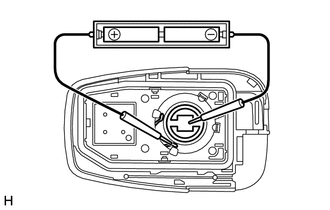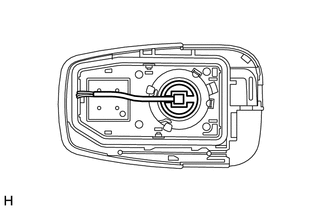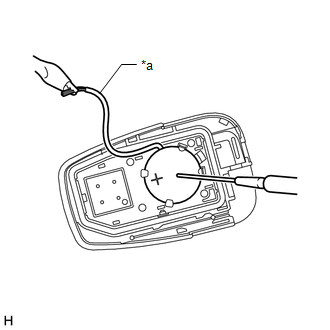| Last Modified: 02-14-2025 | 6.11:8.1.0 | Doc ID: RM1000000014Z6B |
| Model Year Start: 2018 | Model: Camry HV | Prod Date Range: [07/2017 - ] |
| Title: DOOR LOCK: DOOR CONTROL TRANSMITTER: INSPECTION; 2018 - 2024 MY Camry HV [07/2017 - ] | ||
INSPECTION
PROCEDURE
1. INSPECT ELECTRICAL KEY TRANSMITTER SUB-ASSEMBLY
(a) Inspect the operation of the electrical key transmitter sub-assembly.
(1) Remove the transmitter battery from the electrical key transmitter sub-assembly.
|
(2) Install a new or known good transmitter battery. NOTICE: When replacing the transmitter battery, before starting work, remove static electricity that has built up in the body by touching, for example, the vehicle to prevent the electrical key transmitter sub-assembly from being damaged. HINT: If a new or known good transmitter battery is not available, first connect 2 new 1.5 V batteries in series. Then connect leads to the batteries and apply 3 V to the electrical key transmitter sub-assembly, as shown in the illustration. |
|
(3) From outside the vehicle, approximately 1 m (3.28 ft.) from the driver door outside door handle, test the electrical key transmitter sub-assembly by pointing its key plate at the vehicle and pressing an electrical key transmitter sub-assembly switch.
OK:
The door lock can be operated via the electrical key transmitter sub-assembly.
The LED comes on more than once.
- The operational area differs depending on the user, the way the electrical key transmitter sub-assembly is held, and the location.
- The weak radio waves of the electrical key transmitter sub-assembly may be affected if the area has strong radio waves or noise. The electrical key transmitter sub-assembly operation area may be shortened or the electrical key transmitter sub-assembly may not function.
(b) Inspect the transmitter battery capacity.
(1) Remove the transmitter battery from the electrical key transmitter sub-assembly that does not operate. Attach a lead wire (0.6 mm (0.0236 in.) in diameter or less including wire sheath) with tape or equivalent to the negative terminal.
NOTICE:
Do not wrap the lead wire around a terminal, wedge it between the terminals, or solder it. A terminal may be deformed or damaged, and the transmitter battery will not be able to be installed correctly.
|
(2) Carefully pull the lead wire out from the position shown in the illustration and install the previously removed transmitter battery. NOTICE: When replacing the transmitter battery, before starting work, remove static electricity that has built up in the body by touching, for example, the vehicle to prevent the electrical key transmitter sub-assembly from being damaged. |
|
|
(3) Check the transmitter battery voltage. HINT:
Standard Voltage:
If the result is not as specified, replace the transmitter battery. |
|
|
|
|
![2018 - 2024 MY Camry HV [07/2017 - ]; DOOR LOCK: TRANSMITTER BATTERY: REPLACEMENT](/t3Portal/stylegraphics/info.gif)


